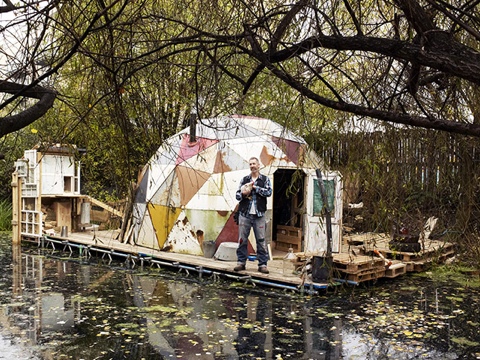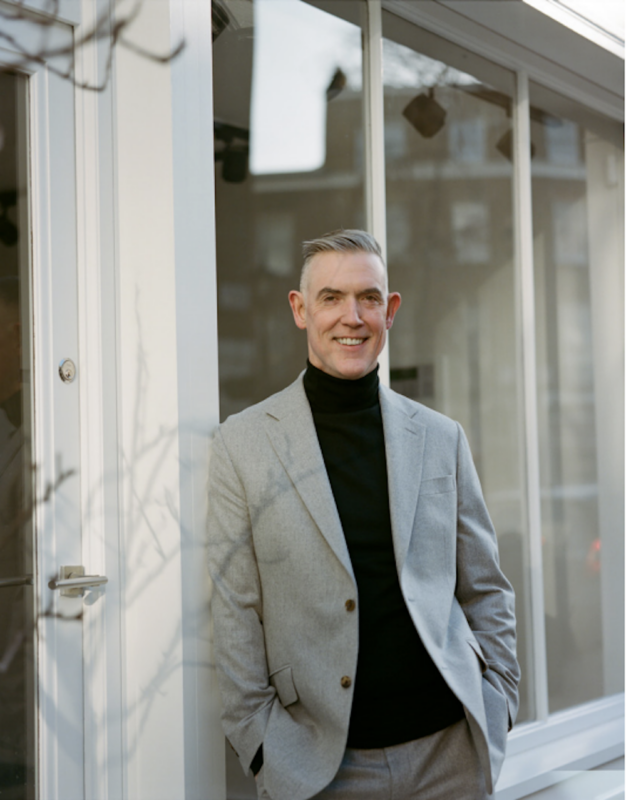
Last Monday, at about 9.30am, I became a citizen of a nation called Nowhereisland. Unlike becoming a British citizen, a tricky process which involves being tested on the number of parliamentary constituencies, joining the nascent population of Nowhereisland was easy. I logged on to its website, supplied my name, address and age and… tah dah! Job done. As I write, Nowhereisland’s population is 3,323: still a way off that of Monaco (30,539) and Liechtenstein (35,236), but already rather bigger than that of the Falkland Islands (3,140). Unlike these places, however, newcomers to Nowhereisland are welcome irrespective of their ability to make a living or the size of their bank balances. Handy. A certificate proving my status will, therefore, be arriving in the post in the next few days.
Nowhereisland is the brainchild of Alex Hartley, a British artist, and its physical manifestation – a floating sculpture made mostly of matter collected from an island in the High Arctic – is to be one of the 12 projects in the (clumsily titled) “Artists taking the lead” section of next year’s Cultural Olympiad. But we will come back to this piece of genius/madness. Nowhereisland’s 500-mile journey around the south-west coast of England – the island will be pulled along by a tug and moored at several ports en route – does not begin until July 2012. In the meantime, you need to go to Victoria Miro in Islington, north London, to see his latest show, The world is still big – a mix of photographs, sculpture and installation (plus, in the gallery’s project room, a kind of trailer for Nowhereisland).
It’s a beautiful, involving and thought-provoking exhibition and, should you fail properly to grasp its nuances, you can always holler Hartley’s name, loudly, across the ornamental pond at the back of the gallery. Perhaps he will appear and answer your questions. For here, for the duration of his show, the artist will be living in a copy of one of the “eco domes” made famous by the hippies of Drop City, Colorado, in the 60s.
From the outside, the dome looks ramshackle, especially compared to the sleek lines of the gallery: made from rusting car bonnets cut into triangles, it’s a lunar module as designed by Harold Steptoe. A chicken coop – the hens travelled with Alex from his home in Devon – only adds to the feeling of slight desperation. Inside, though, it’s unexpectedly cosy. The walls have been lined with hessian and, thanks to a wood-burning stove, it’s warm.
Is it spooky at night, when the gallery is empty? Hartley smiles. “It is a bit spooky, yes. But there’s loads of wildlife: a heron and a fox that lives under the pontoon.” His first sleepover was rudely interrupted when the stove overheated, melted part of his chimney and smoke poured in. But he has fixed this problem now and seems quite content. What did Victoria Miro think when he told her of his plans? Wouldn’t she have preferred that he build, say, an elegant glass box? “Luckily, she was really into it. Sometimes, though, you just have to be a bit ballsy and say, ‘This is what I’m doing.'” And his chutzpah, he thinks, has paid off. The dome has exceeded his expectations. “The smoke and the chickens animate it,” he says. His new home is at once out of time, and out of place, and yet, somehow, alive.
Hartley’s work seeks to explore the connection between habitation and wilderness, between belonging and isolation. It’s about the seeking of sanctuary, the search for peace in a noisy world, but it also suggests a dystopian future in which such things are necessary for survival rather than chosen. (Hartley was born in 1963 and, like me, grew up at a point in history when children lived in fear of the bomb and perhaps this plays into it, too.) As a result, it makes you feel calm, transported, but anxious, too.
The world is still big consists, apart from his dome, of a series of large-scale photographs, mostly of the Arctic and South America. Except they are not only photographs. Examine them closely and you will see that Hartley has built, or rather stuck, scaled architectural models on to, and sometimes into, their surfaces. In The future is certain, a photograph of the lonely border between Argentina and Chile, tiny caves have been built into a rocky cliff. In Outpost, an icy Arctic mound has been topped by a space-age bunker. In I’m tired of travelling, a rudimentary tent has been cast on to a backdrop of ancient woodland and mossy stones. What is interesting about these images is that even the more benign landscapes – one photograph was taken in the sunshine of Joshua Tree, California, another in Sardinia – come to seem menacing once Hartley has added his constructions.
“I’m not like Wolfgang [Tillmans, the Turner prize-winning photographer],” he says. “I’m not a very good photographer. I have to do something else, make some kind of intervention. But I live with the photograph, which is a static thing, day after day at first. That’s when I build a past into it, create a narrative for it, and that’s what excites me. But just making a nice new house wouldn’t really take me anywhere and so the original scene seems to deteriorate almost in front of me. I can’t help it.”
Look carefully at I don’t know where I am, a photograph of a stark South American plain, and you will see the scant remains of a burnt wooden dwelling and four tiny wooden crosses. On Waiting for Daylight to End, meanwhile, Hartley has built a facsimile of the Unabomber’s cabin in a woodland clearing.
After we’ve looked at the photographs, we contemplate Bivvy, a fibreglass sculpture of a tent in a snowdrift, which sits right in the middle of the gallery. The effect is to make the visitor imagine that the artist might not have made it back from his latest trip, that his frozen, mummified body is even now lying inside it. Then we head for the gallery’s project space where photographs of Hartley’s discovery of Nowhereisland in 2004 are on display – together with a world map showing the location of all its new citizens (among my fellow Nowhereislanders are Rachel Whiteread, Hugh Fearnley-Whittingstall and Tim Smit, the chief executive of the Eden Project).
Nowhereisland isn’t an easy project to sum up, as its creator found when he pitched his idea to the Arts Council, which is funding the project. But I will have a go. In 2004, Hartley travelled to the High Arctic with Cape Farewell, an organisation dedicated to encouraging a cultural response to climate change. (It was with Cape Farewell that Ian McEwan travelled to the far north, an experience he later put into his novel, Solar.) During this trip, Hartley discovered a small island, Nymark (“new ground”), which had been revealed by the melting ice of a retreating glacier in the Svalbard archipelago, 500 miles off the coast of Norway. He was the first man to stand on it and, with the help of the Norwegian Polar Institute, had it registered on maps and charts.
At first, Hartley simply wanted to photograph the island. “Standing on it was a huge thrill,” he says. “I mean, it was properly thrilling, and I just wanted to record that, really, and to get a funny letter back from the governor of Svalbard when I wrote to him inquiring about sovereignty.” But then he got to thinking. What if his island travelled south in search of a population? Having got permission from Svalbard’s governor, he returned to Nymark and removed some material from it. It is this matter – glacial moraine, mostly – that he will turn into Nowhereisland, his floating sculpture.
Nowhereisland will be accompanied by (on land) its own embassy, a staffed mobile museum full of information about the project. Online, meanwhile, you can already read about its constitution – a work in progress – and statements by its “resident thinkers” (among them are Tim Cresswell, professor of human geography at Royal Holloway, Sir John Tusa, ex managing director of the BBC World Service, and Philip Hoare, author of Leviathan or, The Whale). The idea is that Nowhereisland will ask questions about migration, sovereignty and global warming. Above all, though, it wonders: what would life be like in a place where we could start from scratch? How would its people grow their food, fund their arts and travel around? Nowhereisland, established in response to the failure of other states to address global crises, seeks to redefine what a nation can be.
Back in his eco dome, Hartley tells me that he is a little nervous “about all this interaction”. For him, it represents a significant and mildly alarming expansion of his artistic practice, which hitherto has been somewhat more solitary. And not everyone is going to get it. In the south-west, politicians, on being told of the plan for the island to visit their towns, have already muttered about the waste of public money involved. Then again, it will be a privilege to have his work seen by so many people, some of them stumbling on the mysterious island as they go about their day. “I’m interested in the dog walker who spots us from a cliff as much as in a group of visiting schoolchildren,” he says. He settles down to cook me lunch on his stove: a sausage and puy lentil concoction, whose meaty components come from his own pigs.
What will happen to his new home when the show ends in January? “Oh, I’ll take it back to Devon,” he says. “I’d be sad not to keep it with me.” For now, though, he is going to enjoy the curious peace it affords: it has a hermetic quality that makes you forget you are in the heart of London. He calls this dome, hunkered and hidden, art. But you could also call it, literally and metaphorically, the quiet before the storm.
Nowhereisland will be moored at Weymouth, Dorset from 25 July 2012 before beginning its journey around the south-west coast of England, arriving in Bristol on 9 Sept. For more details, go to nowhereisland.org
guardian.co.uk © Guardian News & Media Limited 2010
Published via the Guardian News Feed plugin for WordPress.









